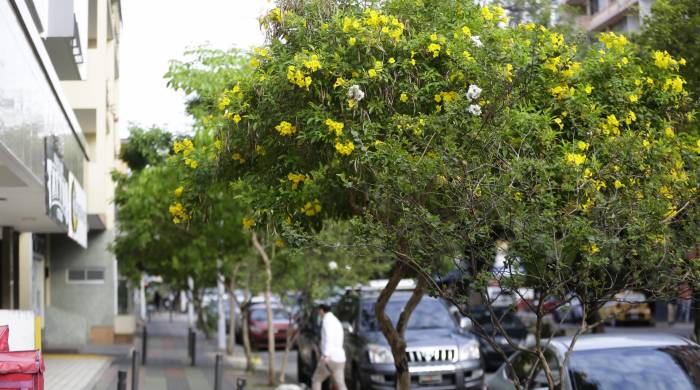Annual bloom of native Panamanian tree should be appreciated.
- By : James Bryson
- Category : Local Culture

The flowering of the guayacan trees becomes a visual spectacle every year, between the months of March and April, that paints the horizon of the Panamanian capital yellow, somewhat gray in recent months due to high environmental pollution.
“The Guayacán is not an endemic species in Panama, but it does grow naturally in our forests, especially in those in the interoceanic canal area,” the botanical biologist from the Protected Area and Biodiversity Directorate of the Ministry of Environment explained to EFE. , Adrián Jiménez.
According to Jiménez, it is in the canal area where the “oldest guayacan trees in Panama are found, they are between 40 and 50 years old and are at their climax.”
The guayacán takes “10 to 15 years to produce its first flowers and that will depend on factors such as soil conditions, soil humidity, among others.”
Among the characteristics of this species are that it is slow growing, requires a lot of precipitation in its initial stages, measures up to 50 meters in height, grows in humid to very humid climates and, in addition to its ornamental beauty, it has good wood.
They announce winter
This species of trees maintain a natural clock of the change of season, because it is known that when they begin to flower, “summer has come to an end.”
“These species detect that the rains will arrive and at that moment they begin to flower,” said Jiménez.
He admitted that in recent years in Panama “we have had a strong impact from the El Niño phenomenon,” with the consequent drought, and this decrease in rainfall has “affected these species, in a certain range, in terms of their flowering.” .
For the most part, the botanist details, they bloom synchronously, but the climatic influence has caused “some to bloom hastily, so to say in December, or very late, in the month of May.”
There are not only yellows
“In Panama we have around 7 species of guayacanes,” noted the biologist. Yellow is the best known to most, but there are those with purple, pale pink and pink flowers.
“The color of its flowering is defined by genetic patterns that determine these types of characters such as the shape and color of the flower,” he stressed.
In Panama, beyond coloring the canal area and the Panamanian capital, the various species and subspecies of guayacán can be seen in the humid forests of the provinces of Colón, Chiriquí and Darién.
The expert did not specify an exact figure of how many guayacanes there are in the capital, but commented that initiatives have been taken to plant many in various parts of the city, including Parque Omar, Camino Real de Bethania, Vía Italia and Plaza Catedral.
They are protected in Panama and internationally
Guayacán wood, according to the expert, is sought after for ship decks, railroad sleepers, furniture, tools, house structures, among other things, which is why in Panama it is within the category of “threatened species.”
“The guayacán is protected by national legislation, our 2016 threatened species resolution,” he stated.
The expert maintained that it will soon enter Appendix 2 of the Convention on International Trade in Endangered Species of Wild Fauna and Flora (Cities) and this will give it a degree of international protection.
“In order for its wood to be marketed abroad, it requires permits from the Ministry of the Environment, basically maintaining control of the export of wood abroad,” he pointed out.



No Comments